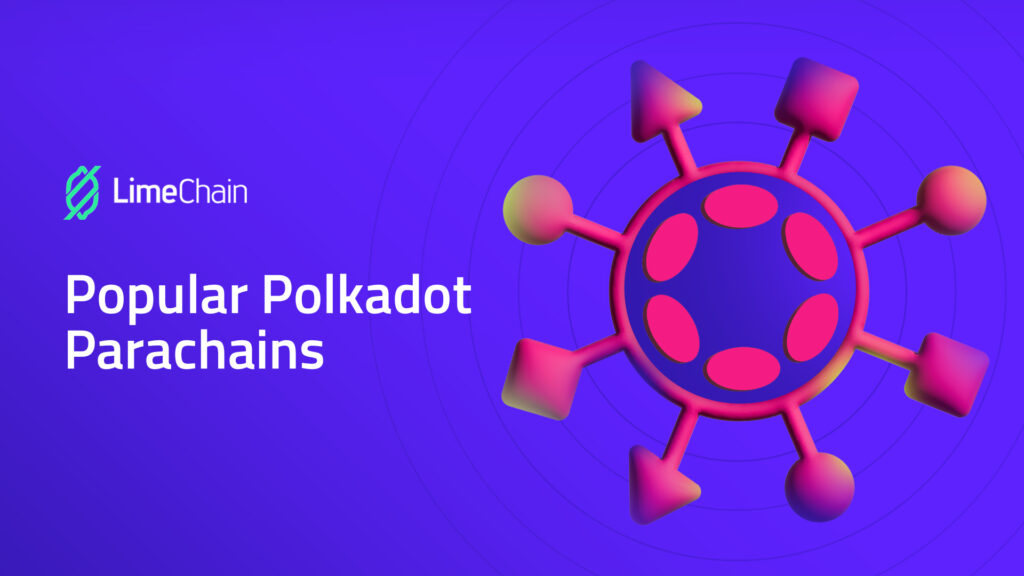

Polkadot is one of the most prominent and ambitious Web3 protocols out there. The protocol seeks to be a ‘blockchain for blockchains’, an ambitious vision that is getting closer and closer to becoming a reality.
On these pages we’ve already examined in detail how Polkadot seeks to achieve this vision through an ever-expanding ecosystem of shard chains, called parachains, that can be fine-tuned to serve specific use cases. In this article, we’ll be taking a look at some of the best Polkadot parachains out there
Disclaimer: LimeChain is not involved in any capacity in any of the projects listed below.
Moonbeam
One of the things that led to the dominance of Ethereum in the Web3 world is the network’s ability to execute smart contracts.
Moonbean is one of the Polkadot parachains that aim to bring smart contract support to the Polkadot ecosystem.
Moonbeam is an Ethereum-compatible smart contract chain for Polkadot that makes it really easy to use Ethereum contracts on Polkadot. The parachain supports popular languages for smart contract development such as Solidity and Vyper, as well as anything that compiles to EVM code.
So all this essentially means that you can redeploy your existing Ethereum smart contracts to Moonbeam without having to rewrite them. You can use popular Ethereum tools such as Metamask, Truffle and Hardhat, as well as leading libraries like Web3.js and Ethers.js.
Astar Network
Astar network is another popular smart contract parachain. Coming from Japan, the platform supports both the Ethereum Virtual Machine and WebAssembly, and uses a ‘cross-virtual machine’ to ensure interoperability between the two environments. Astar also supports a number of Layer 2 solutions, including prominent ZK rollups.
Astar also features an innovative ‘dApp staking’ program called Build2Earn, whose goal is to incentivize Web3 developers to build great dApps for the platform. Astar Network already boasts more than 50 dApps in its ecosystem, with some of the most popular ones being ArthSwap, Astar Exchange and Avault.
Acala Network
Acala Network is a parachain that specializes in decentralized finance and, as such, has been optimized for DeFi apps. It comes with a number of built-in tools such as a DEX, DOT staking and an over-collateralized stablecoin called aUSD. The parachain also boasts EVM compatibility, giving developers the option to build dApps in Solidity, as well as in Polkadot’s native dev framework, Substrate.
In addition, Acala also provides backend infrastructure for institutional-grade financial solutions.
The parachain’s native token ACA is the utility token of the network and is used for a variety of purposes, such as smart contract execution, micro gas fees and node incentives, among others. The Acala token also serves as a governance token for the network.
According to the Acala Network website, the platform currently has just over $180 million of Total Value Locked and nearly 178,000 account holders.
Efinity
Efinity is a parachain focused on NFT gaming and built by Enjin – a Web3 company that develops software for generating and managing non-fungible tokens. Having originally launched on Ethereum, Enjin later opted to create a proprietary Polkadot parachain to avoid the high gas fees associated with the Ethereum network.
Efinity has developed its own token standard for Polkadot called Paratoken. The standard is designed to be compatible with parachains, parathreads and smart contracts and can be used across the entire Polkadot ecosystem. The Paratoken standard can be used for fungible, non-fungible tokens and ‘group NFTs’. The platform has its own native paratoken called EFI.
Centrifuge
Centrifuge is an ambitious project, whose goal is to bring real-world assets to the world of decentralized finance. More specifically, businesses can use the Centrifuge’s Tinlake dApp to tokenize their real-world assets by minting NFT representations of these assets. The NFTs can then be used as collateral for loans from Tinlake liquidity pools. In exchange for their services, liquidity providers earn yield on the capital that has been loaned out.
The future of Polkadot parachains
Polkadot parachains offer plenty of opportunities for optimization. The fact that parachains can be optimized for specific uses has the potential to enable a new wave of dApps that are more efficient and more accessible than the current crop of Web3 products.